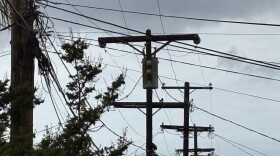Chris Hodges, the principal of Gaylord High School in Otsego County, Michigan, never thought he'd be a contact tracer.
"I definitely thought, you know, 'Why — why am I doing this?'" he says with a laugh. "That's not what I went to school for."
In what has become a regular part of his school day, Hodges fields reports on his charges — such as hearing from the Health Department of Northwest Michigan that a student had tested positive for the novel coronavirus, and was in school for three days when she might have been contagious.
One Tuesday in April, after the school day was over, he found himself walking the almost-empty halls with a laptop and a tape measure, making a list of other students who sat close enough to their sick classmate that they would need to quarantine.
Lisa Peacock, health officer for the department, says that without the school district's help it would be "literally impossible" to keep up with contact tracing.
The school-age population has accounted for a growing share of recent coronavirus cases across northern Michigan, and Peacock says quickly identifying people exposed to those cases and telling them how to quarantine is crucial to protecting communities and containing spread.
When Hodges first started helping the health department with contact tracing, he found himself calling teachers on weekends, holidays and late in the day after they'd gone home, asking them where a particular student sat and struggling to orient himself in the classroom as they described the student's position over the phone.
It happened so often that he's now requiring each teacher to keep an up-to-date seating chart in a bright-yellow folder on top of their desk, so he can find it easily.
But in this case, the teacher, Hannah Romel, was still at school. The student Hodges was tracing is in her yearbook class, which has different seating arrangements every day. Romel handed Hodges the three charts, and he got to work.
In each place Romel had marked the student, Hodges extended his tape measure to the surrounding desks.
Teachers have spaced their seats out as much as they can, he says, but sometimes they can't quite get to the 6-foot distance required to avoid counting a student as a close contact.
(The federal Centers for Disease Control and Prevention updated its guidance last month to allow for 3-foot distancing between desks, but only in communities where transmission is low. In this district, Superintendent Brian Pearson explains, during Michigan's recent surge in cases, 6-foot separation is the standard.)
Hodges moved quickly, both because if he didn't complete the contact tracing the same day, the school can't open the next, and because he wanted to get in touch with the families of students exposed to the virus right away.
"We want to make those phone calls as soon as we can, so that those students aren't at work, aren't at church, aren't going to other people's houses. We want to prevent the spread of COVID not only inside our walls, but in our community," he says.
Hodges then passes on the information, about who was in close contact with the infected student, to the local health department. Other nearby school districts run similar operations.
Nationally, this kind of relationship between schools and health departments is not typical in normal times, but it is happening with some regularity during the pandemic, according to Adriane Casalotti, chief of government and public affairs for the National Association of County and City Health Officials.
Public health funding has declined over the past few decades, she says, forcing local departments to cut staff members who could have boosted their contact-tracing capacity.
Still, getting schools and health departments to work together can greatly help communities, Casalotti says.
Peacock, the local health officer, says that once her staffers get word of exposures at local schools, they will also get in touch with the families to talk them through the details.
"People always have questions," she says. "They have questions about 'What does this mean? What does it mean that I'm quarantined for 14 days?' We recognize that."
And, in some cases, the health department needs more information than Hodges can give, Peacock adds. They might want to find out whether a coronavirus variant is at play, or do a more detailed investigation of how students got sick and where they were, when they were contagious.
Back in Romel's yearbook classroom, Hodges found two students had sat within an area just shy of 6 feet from their classmate who tested positive. They'll need to quarantine for two weeks from the date of this last exposure.
Romel says she's still surprised when she gets the news that a student has gotten sick or infected.
"I worry about the kid," she says. "I hope that it's a mild case, and they get to just be OK and get back to school after their quarantine period and come back and be learning with us again."
After a quick chat with Romel about whether the class did any group work on the days in question (they didn't, which Hodges says is a relief, because it complicates his process), he headed off to the next classroom.
In all, 14 students will be quarantined as a result of exposure to this coronavirus case.
That sounds like a lot, but Hodges says that's a far cry from a single day last month, when 15 students tested positive, and each of them had several close contacts. The number of students who had to quarantine from those potential exposures was in the dozens.
Making phone calls to families informing them their child will need to stay home from school for up to two weeks is not an enjoyable part of the day, for him or the families, said Hodges, but in the long run he's gratified to play a role in mitigating the extent of the pandemic.
This story comes from NPR's reporting partnership with WCMU and KHN.
Copyright 2023 WCMU. To see more, visit WCMU. 9(MDAzMjM2NDYzMDEyMzc1Njk5NjAxNzY3OQ001))






